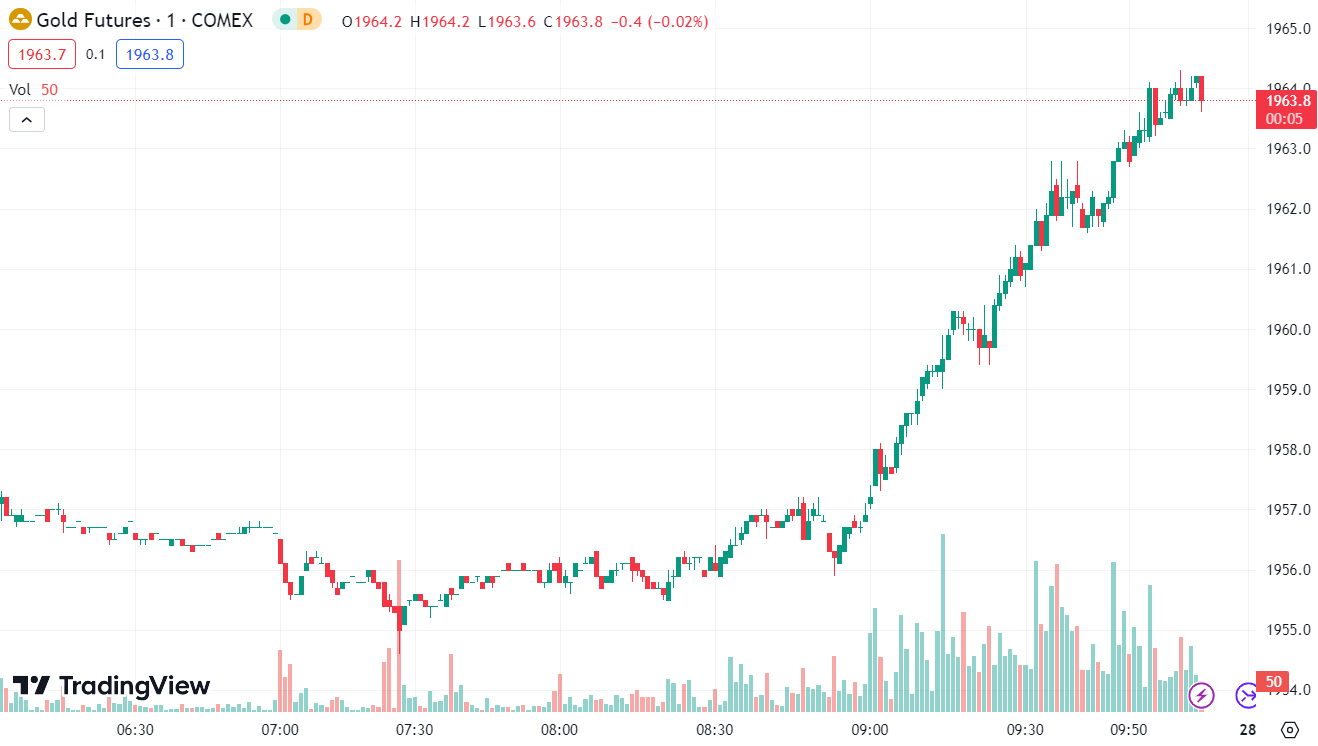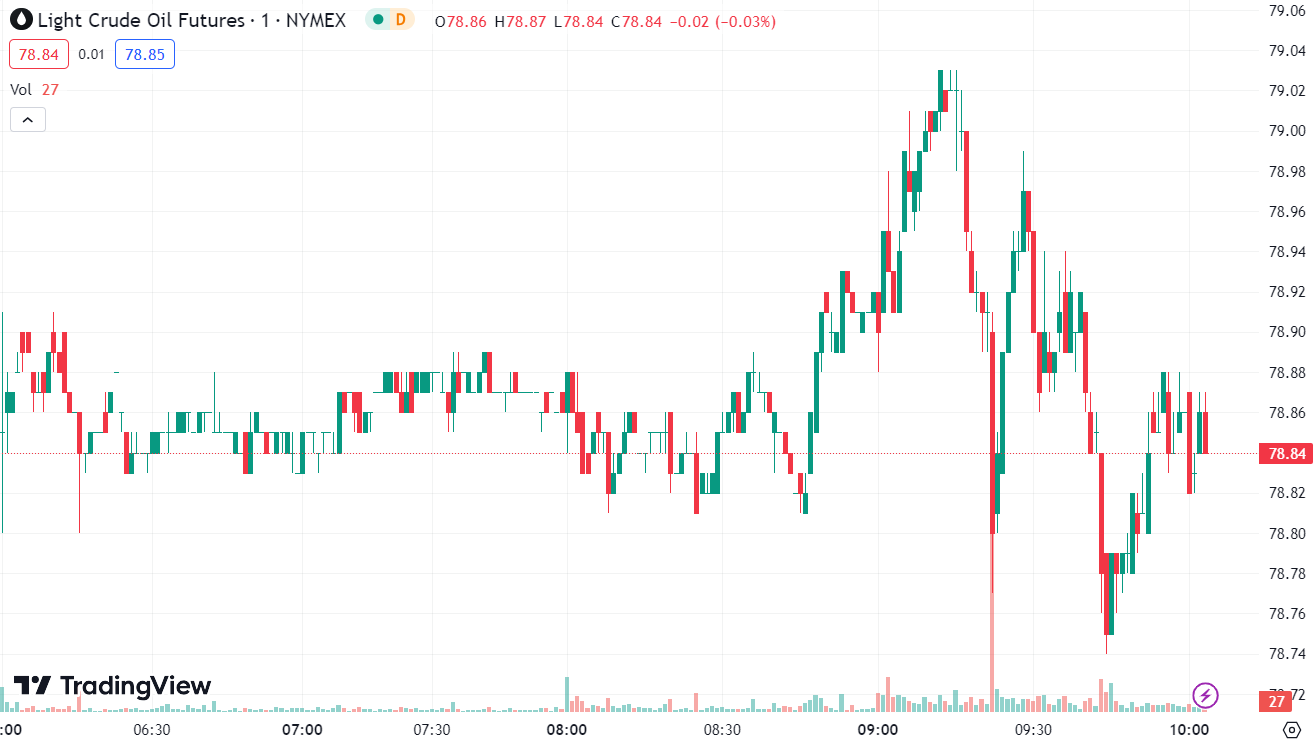
Yesterday’s released economic data showed that the U.S. economy performed better than expected, while the Eurozone’s economy slowed down.
Gold traded in a narrow range, while oil prices rose to a three-month high due to tightening supply. The market is focused on the central bank meetings this week to find clues about the monetary policy outlook.
Gold>>
On Monday, the U.S. released mixed economic data, with strong performance in the manufacturing PMI but a slight decline in the services PMI, leading to a five-month low in the composite PMI. Concerns about sticky inflation persisted, driving the U.S. dollar index up by 0.31% to 101.4.
Gold traded within a narrow range on Monday as the market prepared for the widely expected rate hike by the Federal Reserve and sought clues about future monetary policy.
The rising U.S. dollar index limited the upside for gold. Gold priced in euros reached its highest level since July 5th, as the Eurozone’s July PMI data showed a greater contraction in business activity than anticipated.
Spot gold was constrained by the rebound in the U.S. dollar index and bond yields, falling below the $1960 level for the fourth consecutive trading day and erasing all gains from the past week, closing down by 0.37% at $1954.71 per ounce.
Throughout the day, gold showed relative stability, oscillating around the $1960 level. During the early European session, gold experienced a rebound but faced resistance near $1965 and retraced briefly below $1960 before bouncing back, with the current high testing around $1968.
Technical Analysis:

Today’s short-term trading strategy for gold suggests focusing on short positions during rebounds, with long positions as a secondary approach.
- Key resistance levels to watch on the upside are around 1965-1970.
- Key support levels to watch on the downside are around 1940-1935.
WTI Crude Oil>>
Due to tightening supply and rising U.S. gasoline demand, oil prices climbed about 2% to nearly a three-month high on Monday, with U.S. crude trading around $78 per barrel.
Both major crude benchmarks have risen for four consecutive weeks, driven by production cuts from the Organization of the Petroleum Exporting Countries (OPEC) and allied countries, known as OPEC+. The expected tightening supply, along with strong demand and supply concerns, pushed U.S. gasoline futures to their highest level since October 2022.
Last week, crude oil closed higher with a small bullish candle, regaining its earlier losses and ending at a high level. This week, there is potential for further upward movement.
The weekly chart shows a continuous uptrend with mild oscillations and slow growth, indicating an upward trend. The daily chart remains above the moving averages, showing continued upward momentum.
Despite some retracements, the overall sentiment is bullish on the daily chart. Long positions can be defended on retracements, focusing on the support level around 74.0.
In general, supply shortages are supporting oil prices, and the tight supply situation may become more severe in the future, exacerbated by geopolitical tensions.
Oil prices are expected to maintain a bullish outlook this week, potentially aiming for $80 per barrel ahead of the Federal Reserve’s decision. Investors should closely monitor U.S. economic data and geopolitical uncertainties for potential risks.
Technical Analysis:

Today’s short-term trading strategy suggests focusing on buying on pullbacks and selling on rebounds.
- Key resistance levels to watch on the upside are around 80.0-80.5.
- Key support levels to watch on the upside are around 78.0-77.5.
Forward-looking Statements
This article contains “forward-looking statements” and may be identified by the use of forward-looking terminology such as “anticipate”, “believe”, “continue”, “could”, “estimate”, “expect”, “hope”, “intend”, “may”, “might”, “plan”, “potential”, “predict”, “should”, or “will”, or other variations thereon or comparable terminology. However, the absence of such terminology does not mean that a statement is not forward-looking. In particular, statements about the expectations, beliefs, plans, objectives, assumptions, future events, or future performance of Doo Prime will be generally assumed as forward-looking statements.
Doo Prime has provided these forward-looking statements based on all current information available to Doo Prime and Doo Prime’s current expectations, assumptions, estimates, and projections. While Doo Prime believes these expectations, assumptions, estimations, and projections are reasonable, these forward-looking statements are only predictions and involve known and unknown risks and uncertainties, many of which are beyond Doo Prime’s control. Such risks and uncertainties may cause results, performance, or achievements materially different from those expressed or implied by the forward-looking statements.
Doo Prime does not provide any representation or warranty on the reliability, accuracy, or completeness of such statements. Doo Prime is not obliged to provide or release any updates or revisions to any forward-looking statements.
Disclaimer
While every effort has been made to ensure the accuracy of the information in this document, DOO Prime does not warrant or guarantee the accuracy, completeness or reliability of this information. DOO Prime does not accept responsibility for any losses or damages arising directly or indirectly, from the use of this document. The material contained in this document is provided solely for general information and educational purposes and is not and should not be construed as, an offer to buy or sell, or as a solicitation of an offer to buy or sell, securities, futures, options, bonds or any other relevant financial instruments or investments. Nothing in this document should be taken as making any recommendations or providing any investment or other advice with respect to the purchase, sale or other disposition of financial instruments, any related products or any other products, securities or investments. Trading involves risk and you are advised to exercise caution in relation to the report. Before making any investment decision, prospective investors should seek advice from their own financial advisers, take into account their individual financial needs and circumstances and carefully consider the risks associated with such investment decision.
